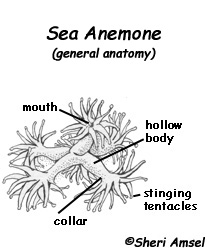

They are found in coastal waters all over the world, mostly in warmer waters. There are many different species of anemone.
They live in mostly warm coastal waters, but some species can live in cooler coastal waters. The live attached to solid objects like rocks, shells or coral reefs.
They can be as small as an inch and as large as 6 feet wide. They have a rounded shape and are hollow inside. They have tentacles that come out their top and surround their mouth. At the bottom of their hollow body they balance on a foot that can slide around on the ocean floor very slowly.
Each tentacle has stinging cells that spring out and shoot poison into any prey that touches them. Butterfly fish and a few species of sea slugs are among the very few animals that can eat the poisonous anemone.
They eat any animal that comes in contact with their tentacles (carnivore).
Male and female anemones shoot their sperm and eggs out of their mouths where they form tiny baby anemones that settle onto a rock and grow. Broken off pieces of anemones can grow new anemones. This is called budding.
When you research information you must cite the reference. Citing for websites is different from citing from books, magazines and periodicals. The style of citing shown here is from the MLA Style Citations (Modern Language Association).
When citing a WEBSITE the general format is as follows.
Author Last Name, First Name(s). "Title: Subtitle of Part of Web Page, if appropriate." Title: Subtitle: Section of Page if appropriate. Sponsoring/Publishing Agency, If Given. Additional significant descriptive information. Date of Electronic Publication or other Date, such as Last Updated. Day Month Year of access < URL >.
Amsel, Sheri. "Sea Anemone" Exploring Nature Educational Resource ©2005-2024. December 13, 2024
< http://www.exploringnature.org/db/view/Sea-Anemone >

